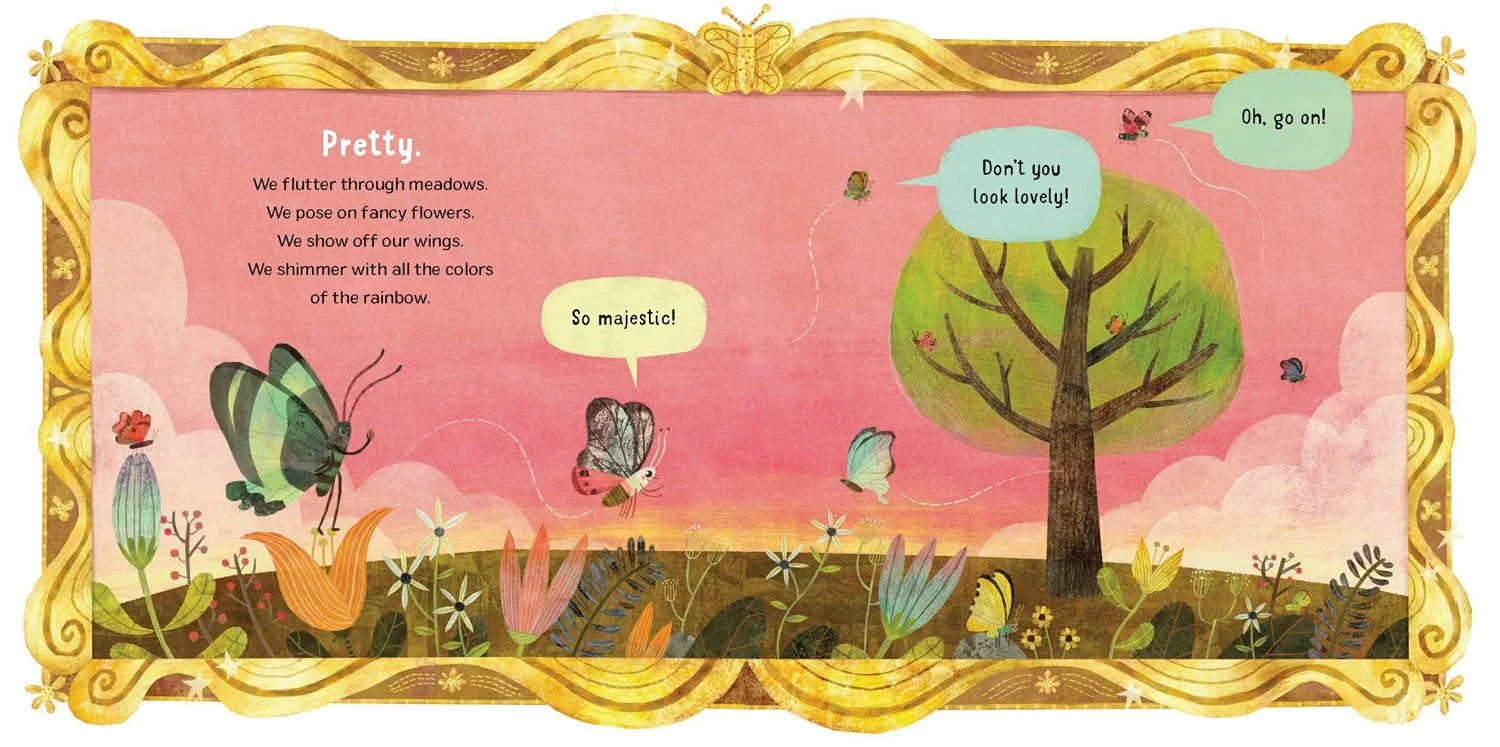Q & A with Rosemary Mosco
by Julianne Black DiBlasi
When a little cartoon butterfly pleads with you not to turn the page, do you? What dark secrets or deplorable behavior would something as sweet and beautiful as a butterfly need to hide?
And, yes, I did turn the page. I was shocked! I was horrified! I was entirely tossing-of-cookies-level grossed out! And I laughed the whole time.
This is one of those key picture books that not only introduces kids to science, but holds their hands, gives them a cookie, and makes them snort out loud laughing while the education seeps in accidentally (yet on purpose). It was as if the author was a scientist and a cartoonist! Like the author knew how to talk to kids about our amazing natural environment through many years of formal study and keynote speeches … oh wait. That’s exactly it.
Story Monsters, let me introduce to you the tremendously multitalented Rosemary Mosco, author of the book Butterflies Are Pretty ... Gross!
Q: I love that the science part of your life bubbled up into fun avenues like your comics and children’s books. Can you tell us a bit about how that evolved? Which came first?
A: As a little kid I loved both science and comics. It was natural for me to try mixing them together, so I made a lot of nature comics as a kid. When I got older, I spent a lot of time trying to figure out how to combine biology and art into a career. I worked in various communication jobs and experimented with a lot of projects. Finally I got the opportunity to write a comic book in the First Second line of science comics, and it felt like such a natural thing. I dove into book writing and I never looked back.
Q: Your keynotes and workshops have taken you all over the place! Any favorite venues or audiences along the way?
A: I’ve gotten to go to so many interesting places, but Salt Lake really stands out. I visited the city for the Great Salt Lake Bird Festival. The night of my talk, which was at a beautiful nature center, an adorable long-tailed weasel ran through the open doors and into the room. It scurried around for a while, to everybody’s delight. Later, we all ate a spectacular dinner of traditional Mormon Dutch oven food. Mmm. I still think about the peach cobbler.
Q: As per your website, your favorite glacial landform is the esker. I mean really, whose isn’t, but can you tell us why?
A: I’m so glad you asked! Where I live in the U.S. northeast, the land was once covered in glaciers a mile thick. When the glaciers started to melt away, the meltwater collected in huge rivers that flowed through the ice. Like all rivers, they carried little stones and other sediment that settled at the river bed. But then the ice melted fully away from around the rivers and left stream-shaped roads of gravel. You can walk on these raised, road-like gravel beds today, and marvel at the size of the lost glaciers.
Q: I love the twist of taking an iconicity delicate creature like a butterfly and turning it factually on its head. Can you tell us a little about how the idea came about?
A: A few years ago I heard a woman say, “I love all insects except for butterflies, which are just boring and girly.” I wanted to reclaim butterflies in all their weird glory. Like girls—like all people—butterflies are at times complex, wild, and strange. That complexity is beautiful.
Q: The illustrations are so well matched to the feel of the text, how much influence did you have on art direction? What were your thoughts seeing the initial drafts?
A: I write my books as if they’re comic book scripts, with some general direction on each page. But the illustrator on this project, Jacob Souva, added so much more detail and interest. I like it when illustrators get a lot of free rein. They always elevate my work into something spectacular. When I saw the initial drafts, I was thrilled! I’m still finding tiny details in those illustrations.
Q: Your book is getting rave reviews on Amazon and other sellers! How have live readings come across to the audience? Any favorite comments or interjections from young audiences?
A: I haven’t done a ton of live readings, but when I have, I’ve loved hearing kids laugh. When I make them laugh, I know I’m succeeding at my job—science is easier to retain when it’s funny!
Q: If there was anything you could have added to the book post publication, what would it be?
A: I don’t think there’s anything I could add. I suppose I wish there was some kind of multimedia component, since it’s really fun to actually hear the crack of a Red Cracker butterfly’s wings, or watch butterflies flying. But now kids can go out there and find those wonders themselves!
Q: What’s in the works that you can give our Story Monsters a hint about?
A: I have a follow-up to Butterflies Are Pretty ... Gross! about botany. It’s called Flowers Are Pretty ... Weird! I’m also releasing a graphic novel this year about urban wildlife. And I’m dreaming up some more projects about birds and bugs. Stay tuned. I love sharing science and I’m not stopping!
You can read more about Rosemary Mosco at
rosemarymosco.com or follow her on FB: @BirdAndMoon,
Tw: @RosemaryMosco, IG: @rosemarymosco.




